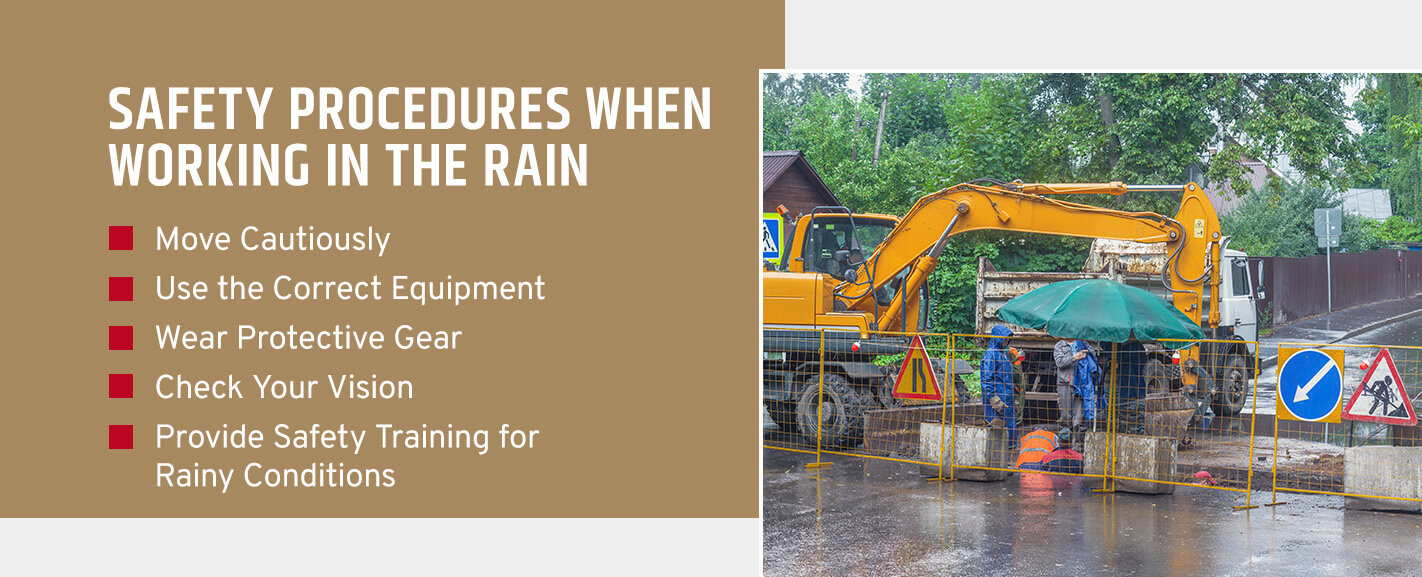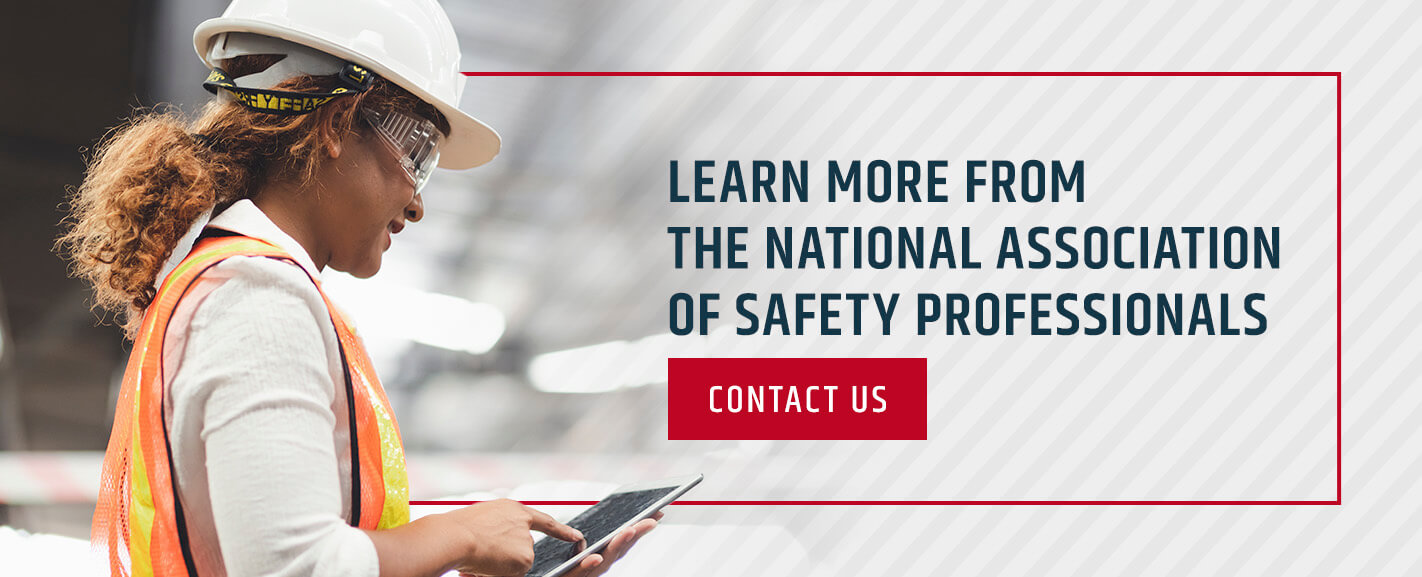
As a safety professional, knowing the safety protocols in different weather conditions is crucial to protecting yourself and your workers. Working in the rain can increase hazards, so it’s best to train the employees and provide the necessary equipment to help them perform optimally and safely when the weather turns. Learn about the proper safety procedures for rainy conditions below.
Legal Considerations When Working in the Rain
Government agencies responsible for ensuring workplace safety, such as OSHA, provide safety guidelines to ensure optimum protection for safety professionals and their teams. Common laws also seek to protect workers and enable them to claim compensation when they get injured on the job site. Working in the rain can pose additional hazards, so it’s essential to stay compliant while reducing injuries and liabilities.
Here are some important things to keep in mind:
1. Rain-Related Guidance
Specific OSHA regulations or standards for working in the rain may not exist. However, the general duty clause under OSHA requires employers to provide a safe workplace offers helpful insight.
Rain can increase workplace hazards and make tasks more challenging to execute. Besides obstructing vision, rain can cause surfaces to be slippery, leading to injuries, especially when the workers lack the requisite training, skills, and tools to perform the job. Safety professionals may only continue operations if they can ensure the safety of their employees.
2. Cold Stress Guidance
Working in a cold environment can expose you to cold stress, leading to illnesses or injuries such as hypothermia, frostbite, trench foot, and chilblains.
OSHA’s cold stress guide advises that cold stress can occur without freezing temperatures. For example, a person can contract hypothermia at temperatures above 40°F when chilled from sweat, rain, or submersion in cold water. It’s vital to use protective clothing, particularly layers with an outer material that protects against wind and rain.
3. Rescue and Recovery Work
Safety professionals and their teams are usually one of the first groups contacted during emergencies. These professionals venture into dangerous territories to provide assistance, exposing themselves to hazards such as electrocution and harmful chemicals.
OSHA directs that such situations require properly trained workers with sufficient experience and protective equipment. That way, the chances of survival are maximized. Besides OSHA’s flood preparedness and response guidelines, the agency has guidance on hurricanes and guidance on tornadoes.
4. Emergency Action
An effective way to protect workers during adverse weather conditions is to prepare relevant preparedness, emergency, and response plans. OSHA’s requirement under the 29 CFR 1910.38 standard is that employers prepare written emergency action plans, including crises caused by bad weather. However, employers with 10 or fewer workers may verbally communicate the action plan.
5. The Hierarchy of Controls
Employers and safety professionals are required to identify relevant workplace hazards, including those arising from weather-related emergencies, through hazard assessments and implementing safety policies and protocols.
Using the CDC’s hierarchy of controls is an important starting point. It enables you to establish workplace emergency procedures according to the job site’s requirements and helps protect workers against hazards posed by rains, strong winds, and storms.
6. Common Law Rules
Common law rules impose a duty of care on employers and other persons responsible for workers’ safety to implement measures to eliminate or mitigate workplace injuries. The standard of care required may vary depending on the situation. However, the standards for working in the rain are mostly higher than in dry conditions.
Safety Procedures When Working in the Rain
Common hazards when working in the rain include electrocution, lightning strikes, drowning, slips and falls, cold stress, and falling objects. Here are some safety procedures and tips for working in the rain to help you and your team limit these risks as much as possible:

1. Move Cautiously
Wet conditions increase the chances of injuries, so it helps to move around the worksite with caution. Take small steps and keep your head up to watch for hazards. Also, handle equipment carefully, as it can easily slip off and injure others on the job site. Finally, drive slowly and watch out for hydroplaning.
2. Use the Correct Equipment
Always use the correct equipment for the job. Reduce improvisation and ensure all workers are well-equipped with the tools they need. Consider equipment rated for outdoor applications, like those with textured, nonslip handles, when working in the rain. Inspect your tools to ensure they’re in good condition and avoid machines that use electricity unless they’re rated for use in the rain.
3. Wear Protective Gear
Choose the appropriate gear when working in the rain to mitigate the risk of injury. Fabrics like wool are generally well-insulated and can keep workers warm over an extended period. Select clothing items that allow workers to perform their duties without obstructing their movement.
Workers should also wear bright-colored, reflective clothing to enhance visibility. That way, employees can easily spot each other even from long distances.
Make sure your team wears proper footwear with deep treads to reduce slipping. Gloves improve grip and keep hands warm, serving a dual function of mitigating accidental falls and helping workers maintain the right body temperature.
4. Check Your Vision
Goggles protect your eyes, but if you plan to use them in the rain, use anti-fog spray or wipes to make sure they remain clear. Ensure rain hats or hoods don’t obstruct vision, either. Stay within co-workers’ line of sight when working in dark areas or on sites with heavy machinery or vehicle traffic.
5. Provide Safety Training for Rainy Conditions
As a pro tip, conduct regular and practical training for your workers. That way, the safety protocols become second nature to them.
Practical training programs and certification do more than ensure compliance — they help workers to understand the risks of hazards and how to avoid or work through them. Safety protocols such as first aid can also help save lives in emergencies.
Learn More from the National Association of Safety Professionals
The National Association of Safety Professionals (NASP) is dedicated to improving workplace safety on job sites, regardless of the weather conditions. We aim to ensure workers and professionals are prepared to handle daily challenges with workplace safety training for general industry, construction, oil and gas, and governmental agencies and provide the necessary certifications.
We’re IACET-accredited for Continuing Education Units, with years of experience helping workers stay safe. Contact us now to learn more.





